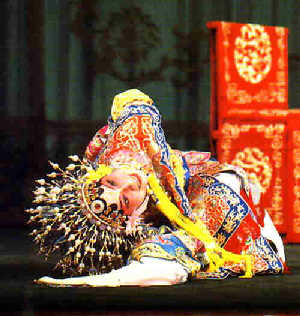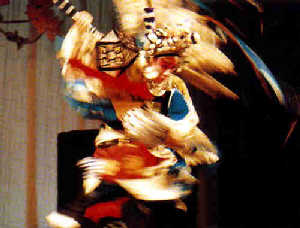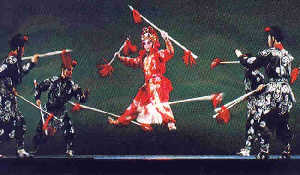Others
Flags are also frequently used on the stage. A square flag with the Chinese character for "marshal" on it, a rectangular flag with the Chinese character for "commander" on it, and a flag with the name of a certain army on it represent the location of army camps and commanders-in-chief. In addition, there are water, fire, wind, and vehicle flags. Actors shake these flags to represent waves, fire, wind, or moving vehicles.
Waving a whip means riding a horse, and waving an oar means rowing a boat.
 Basic Skills
Basic Skills
The basic skills include dance movements, and special acrobatic movements while singing or reciting. It is very important for all opera actors and actresses to master these basic skills.
The following are the main basic skills:

Waist and leg exercises are necessary for developing the ability to do leaps and somersaults. Dances and acrobatics call for supple waists, so that the performers can control their centers of gravity. Waist and leg exercises include somersaults, swaying from right to left and from left to right, kicks, leg stretches and pulls, and upward straightened leg movements.

Tanzi (carpet) skills are needed to make all kinds of somersaults, leaps, jumps, and falls. It got its name because practice is carried out on a carpet or rug. Most movements, including four-directional somersaults, are done with the hands placed on the ground or with leaps and jumps.

Bazi (bundle) skills are combat techniques. Stage weapons include the broadsword, spear, sword, long-handled ax, hook, fork, and staff. Combat skills fall into three categories. The first is the use of long weapons such as the broadsword, long-handled spear, and staff. The second is the use of short weapons such as the sword, double swords, and dagger. The third is the use of only one's bare hands.
Combat can be either serious or funny. The former emphasizes the characters of the antagonists, while the latter shows off the skills of the performer. Both require that the fighting be emotional, rhythmical, and conventional.
